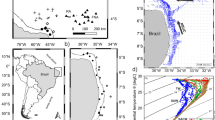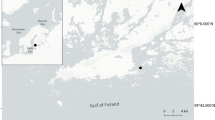Abstract
To elucidate the ecological importance of mixotrophic nanoflagellates in the open ocean and the environmental factors that regulate their abundance, we surveyed latitudinal distributions of autotrophic, mixotrophic and heterotrophic nanoflagellates in the central North Pacific Ocean along a transect at 170°W. Mixotrophic nanoflagellates significantly contributed (26–64 %) to total bacterivory, as measured by the fluorescently-labeled bacteria method, from the equatorial through the subarctic regions, which reinforces the importance of mixotrophic nanoflagellates as a trophic link in the open ocean. The proportion of mixotrophic to total plastidic nanoflagellates was significantly higher in the nutrient-depleted subtropical gyre than in other regions, sometimes exceeding 10 %. Additionally, the proportion was negatively correlated with soluble reactive phosphorus concentration within the tropical and subtropical waters, suggesting that low nutrient availability could facilitate phagotrophy of plastidic nanoflagellates, which may explain the survival of nano-sized eukaryotic phytoplankton in the ultraoligotrophic water. In the subarctic regions, the proportion exhibited no obvious relationship with any environmental parameter. Conversely, the numerical proportion of mixotrophic nanoflagellates in total phagotrophic nanoflagellates (sum of mixotrophic and heterotrophic nanoflagellates) was positively correlated with nutrient concentrations. In contrast to macronutrient availability, the physical stability of the water column did not appear to affect the contribution of mixotrophic nanoflagellates.




Similar content being viewed by others
References
Arenovski AL, Lim EL, Caron DA (1995) Mixotrophic nanoplankton in oligotrophic surface waters of the Sargasso Sea may employ phagotrophy to obtain major nutrients. J Plankton Res 17(4):801–820
Benitez-Nelson CR, McGillicuddy DJ (2008) Mesoscale physical–biological–biogeochemical linkages in the open ocean: An introduction to the results of the E-Flux and EDDIES programs. Deep Sea Research Part II: Top Stud in Oceanogr 55(10–13):1133–1138
Berman T, Bronk DA (2003) Dissolved organic nitrogen: a dynamic participant in aquatic ecosystems. Aquat Microb Ecol 31(3):279–305
Boyd PW, Law CS, Wong CS, Nojiri Y, Tsuda A, Levasseur M, Takeda S, Rivkin R, Harrison PJ, Strzepek R, Gower J, McKay RM, Abrahama E, Arychuk M, Barwell-Clarke J, Crawford W, Hale M, Harada K, Johnson K, Kiyosawa H, Kudo I, Marchetti A, Miller W, Needoba J, Nishioka J, Ogawa H, Page H, Robert M, Saito H, Sastri A, Sherry N, Soutar T, Sutherland N, Taira Y, Whitney F, Wong SKE, Yoshimura T (2004) The decline and fate of an iron-induced subarctic phytoplankton bloom. Nature 428(6982):549–553
Carvalho WF, Granéli E (2006) Acidotropic probes and flow cytometry: a powerful combination for detecting phagotrophy in mixotrophic and heterotrophic protists. Aquat Microb Ecol 44(1):85–96
Carvalho WF, Granéli E (2010) Contribution of phagotrophy versus autotrophy to Prymnesium parvum growth under nitrogen and phosphorus sufficiency and deficiency. Harmful Algae 9(1):105–115
Epstein SS, Shiaris MP (1992) Size-selective grazing of coastal bacterioplankton by natural assemblages of pigmented flagellates, colorless flagellates, and ciliates. Microb Ecol 23(3):211–225
Flynn KJ, Stoecker DK, Mitra A, Raven JA, Glibert PM, Granéli E, Burkholder JM (2013) Misuse of the phytoplankton–zooplankton dichotomy: the need to assign organisms as mixotrophs within plankton functional types. J Plankton Res 35(1):3–11
Gast RJ, McKie-Krisberg ZM, Fay SA, Rose JM, Sanders RW (2014) Antarctic mixotrophic protist abundances by microscopy and molecular methods. FEMS Microbiol Ecol 89(2):388–401
Gerritsen J, Porter KG (1982) The role of surface chemistry in filter feeding by zooplankton. Science 216(4551):1225–1227
Gonzalez JM, Sherr EB, Sherr BF (1990) Size-selective grazing on bacteria by natural assemblages of estuarine flagellates and ciliates. Appl Environ Microbiol 56(3):583–589
Hammer A, Grüttner C, Schumann R (1999) The effect of electrostatic charge of food particles on capture efficiency by Oxyrrhis marina Dujardin (dinoflagellate). Protist 150(4):375–382
Hammer A, Gruttner C, Schumann R (2001) New biocompatible tracer particles: use for estimation of microzooplankton grazing, digestion, and growth rates. Aquat Microb Ecol 24(2):153–161
Hartmann M, Grob C, Tarran GA, Martin AP, Burkill PH, Scanlan DJ, Zubkov MV (2012) Mixotrophic basis of atlantic oligotrophic ecosystems. Proc Natl Acad Sci USA 109(15):5756–5760
Hashihama F, Furuya K, Kitajima S, Takeda S, Takemura T, Kanda J (2009) Macro-scale exhaustion of surface phosphate by dinitrogen fixation in the western North Pacific. Geophys Res Lett 36(3):L03610
Havskum H, Hansen AS (1997) Importance of pigmented and colourless nano-sized protists as grazers on nanoplankton in a phosphate-depleted Norwegian fjord and in enclosures. Aquat Microb Ecol 12(2):139–151
Havskum H, Riemann B (1996) Ecological importance of bacterivorous, pigmented flagellates (mixotrophs) in the bay of Aarhus, Denmark. Mar Ecol Prog Ser 137(1–3):251–263
Landry MR, Lehnerfournier JM, Sundstrom JA, Fagerness VL, Selph KE (1991) Discrimination between living and heat-killed prey by a marine zooflagellate, Paraphysomonas vestita (Stokes). J Exp Mar Biol Ecol 146(2):139–151
Laybourn-Parry J, Marshall WA, Marchant HJ (2005) Flagellate nutritional versatility as a key to survival in two contrasting Antarctic saline lakes. Freshw Biol 50(5):830–838
Litchman E, Klausmeier CA, Schofield OM, Falkowski PG (2007) The role of functional traits and trade-offs in structuring phytoplankton communities: scaling from cellular to ecosystem level. Ecol Lett 10(12):1170–1181
Liu H, Campbell L, Landry MR (1995) Growth and mortality rates of Prochlorococcus and Synechococcus measured with a selective inhibitor technique. Mar Ecol Prog Ser 116:277–287
Maranger R, Bird DF, Price NM (1998) Iron acquisition by photosynthetic marine phytoplankton from ingested bacteria. Nature 396(6708):248–251
Marañón E, Cermeño P, Latasa M, Tadonléké RD (2012) Temperature, resources, and phytoplankton size structure in the ocean. Limnol Oceanogr 57(5):1266–1278
Marchetti A, Sherry ND, Kiyosawa H, Tsuda A, Harrison PJ (2006) Phytoplankton processes during a mesoscale iron enrichment in the NE subarctic Pacific: part I—biomass and assemblage. Deep Sea Res II 53(20–22):2095–2113
Marie D, Partensky F, Jacquet S, Vaulot D (1997) Enumeration and cell cycle analysis of natural populations of marine picoplankton by flow cytometry using the nucleic acid stain SYBR green I. Appl Environ Microbiol 63(1):186–193
Massana R, Unrein F, Rodriguez-Martinez R, Forn I, Lefort T, Pinhassi J, Not F (2009) Grazing rates and functional diversity of uncultured heterotrophic flagellates. ISME J 3(5):588–596
McKie-Krisberg ZM, Sanders RW (2014) Phagotrophy by the picoeukaryotic green alga Micromonas: implications for Arctic Oceans. ISME J 8(10):1953–1961
Millard RC, Owens WB, Fofonoff NP (1990) On the calculation of the Brunt-Väisäla frequency. Deep Sea Res A 37(1):167–181
Mitra A, Flynn KJ, Burkholder JM, Berge T et al (2014) The role of mixotrophic protists in the biological carbon pump. Biogeosciences 11(4):995–1005
Moorthi S, Caron DA, Gast RJ, Sanders RW (2009) Mixotrophy: a widespread and important ecological strategy for planktonic and sea-ice nanoflagellates in the Ross Sea, Antarctica. Aquat Microb Ecol 54(3):269–277
Ng WHA, Liu H (2016) Diel periodicity of grazing by heterotrophic nanoflagellates influenced by prey cell properties and intrinsic grazing rhythm. J Plankton Res 38(3):636–651
Nygaard K, Tobiesen A (1993) Bacterivory in algae: a survival strategy during nutrient limitation. Limnol Oceanogr 38(2):273–279
Raven JA, Beardall J, Flynn KJ, Maberly SC (2009) Phagotrophy in the origins of photosynthesis in eukaryotes and as a complementary mode of nutrition in phototrophs: relation to Darwin’s insectivorous plants. J Exp Bot 60(14):3975–3987
Roberts EC, Laybourn-Parry J (1999) Mixotrophic cryptophytes and their predators in the dry valley lakes of Antarctica. Freshw Biol 41(4):737–746
Rothhaupt KO (1996) Laboratory experiments with a mixotrophic chrysophyte and obligately phagotrophic and photographic competitors. Ecology 77(3):716–724
Safi KA, Hall JA (1999) Mixotrophic and heterotrophic nanoflagellate grazing in the convergence zone east of New Zealand. Aquat Microb Ecol 20(1):83–93
Sanders RW, Gast RJ (2012) Bacterivory by phototrophic picoplankton and nanoplankton in Arctic waters. FEMS Microbiol Ecol 82(2):242–253
Sanders RW, Berninger UG, Lim EL, Kemp PF, Caron DA (2000) Heterotrophic and mixotrophic nanoplankton predation on picoplankton in the Sargasso Sea and on Georges Bank. Mar Ecol Prog Ser 192:103–118
Sanders RW, Caron DA, Davidson JM, Dennett MR, Moran DM (2001) Nutrient acquisition and population growth of a mixotrophic alga in axenic and bacterized cultures. Microb Ecol 42(4):513–523
Sato M, Takeda S, Furuya K (2009) Responses of pico- and nanophytoplankton to artificial iron infusions observed during the second iron enrichment experiment in the western subarctic pacific (SEEDS II). Deep Sea Res II 56(26):2745–2754
Sato M, Hashihama F, Kitajima S, Takeda S, Furuya K (2010) Distribution of nano-sized Cyanobacteria in the western and central Pacific Ocean. Aquat Microb Ecol 59(3):273–282
Sato M, Kodama T, Hashihama F, Furuya K (2015) The effects of diel cycles and temperature on size distributions of pico- and nanophytoplankton in the subtropical and tropical Pacific Ocean. Plankton Benthos Res 10(1):26–33
Sherr EB, Sherr BF (1993) Protistan grazing rates via uptake of fluorescently labeled prey. In: Kemp PF, Sherr BF, Sherr EB, Cole JJ (eds) Handbook of methods in aquatic microbial ecology. Lewis Publishers, Boca Raton, pp 695–701
Sherr BF, Sherr EB, Fallon RD (1987) Use of monodispersed, fluorescently labeled bacteria to estimate in situ protozoan bacterivory. Appl Environ Microbiol 53(5):958–965
Sieracki ME, Haas LW, Caron DA, Lessard EJ (1987) Effect of fixation on particle retention by microflagellates: underestimation of grazing rates. Mar Ecol Prog Ser 38(3):251–258
Stukel MR, Landry MR, Selph KE (2011) Nanoplankton mixotrophy in the eastern equatorial Pacific. Deep Sea Res II 58(3–4):378–386
Suzuki K, Hinuma A, Saito H, Kiyosawa H, Liu H, Saino T, Tsuda A (2005) Responses of phytoplankton and heterotrophic bacteria in the northwest subarctic Pacific to in situ iron fertilization as estimated by HPLC pigment analysis and flow cytometry. Prog Oceanogr 64(2–4):167–187
Tittel J, Bissinger V, Zippel B, Gaedke U, Bell E, Lorke A, Kamjunke N (2003) Mixotrophs combine resource use to outcompete specialists: implications for aquatic food webs. Proc Natl Acad Sci USA 100(22):12776–12781
Tsai AY, Gong GC, Sanders RW, Chen WH, Chao CF, Chiang KP (2011) Importance of bacterivory by pigmented and heterotrophic nanoflagellates during the warm season in a subtropical western Pacific coastal ecosystem. Aquat Microb Ecol 63(1):9–18
Tsuda A, Takeda S, Saito H, Nishioka J, Nojiri Y, Kudo I, Kiyosawa H, Shiomoto A, Imai K, Ono T, Shimamoto A, Tsumune D, Yoshimura T, Aono T, Hinuma A, Kinugasa M, Suzuki K, Sohrin Y, Noiri Y, Tani H, Deguchi Y, Tsurushima N, Ogawa H, Fukami K, Kuma K, Saino T (2003) A mesoscale iron enrichment in the western subarctic Pacific induces a large centric diatom bloom. Science 300(5621):958–961
Tsuda A, Takeda S, Saito H, Nishioka J, Kudo I, Nojiri Y, Suzuki K, Uematsu M, Wells ML, Tsumune D, Yoshimura T, Aono T, Aramaki T, Cochlan WP, Hayakawa M, Imai K, Isada T, Iwamoto Y, Johnson WK, Kameyama S, Kato S, Kiyosawa H, Kondo Y, Levasseur M, Machida R, Nagao I, Nakagawa F, Nakanishi T, Nakatsuka S, Narita A, Noiri Y, Obata H, Ogawa H, Oguma K, Ono T, Sakuragi T, Sasakawa M, Sato M, Shimamoto A, Takata H, Trick CG, Watanabe YW, Wong CS, Yoshie N (2007) Evidence for the grazing hypothesis: grazing reduces phytoplankton responses of the HNLC ecosystem to iron enrichment in the western subarctic Pacific (SEEDS II). J Oceanogr 63(6):983–994
Unrein F, Massana R, Alonso-Saez L, Gasol JM (2007) Significant year-round effect of small mixotrophic flagellates on bacterioplankton in an oligotrophic coastal system. Limnol Oceanogr 52(1):456–469
Unrein F, Gasol JM, Not F, Forn I, Massana R (2014) Mixotrophic haptophytes are key bacterial grazers in oligotrophic coastal waters. ISME J 8(1):164–176
Urabe J, Gurung TB, Yoshida T (1999) Effects of phosphorus supply on phagotrophy by the mixotrophic alga Uroglena americana (Chrysophyceae). Aquat Microb Ecol 18(1):77–83
Ward BA, Follows MJ (2016) Marine mixotrophy increases trophic transfer efficiency, mean organism size, and vertical carbon flux. Proc Natl Acad Sci USA 113(11):2958–2963
Ward BA, Dutkiewicz S, Barton AD, Follows MJ (2011) Biophysical aspects of resource acquisition and competition in algal mixotrophs. Am Nat 178(1):98–112
Zubkov MV, Tarran GA (2008) High bacterivory by the smallest phytoplankton in the North Atlantic Ocean. Nature 455(7210):224–226
Acknowledgments
We appreciate support from the captain and all the crew and officers of the R/V Hakuho-maru during the cruise KH-14-3. This study was financially supported by JSPS Grant 24710004 and 25850129 and MEXT Grants 24121003 and 24121006.
Author information
Authors and Affiliations
Corresponding author
Rights and permissions
About this article
Cite this article
Sato, M., Shiozaki, T. & Hashihama, F. Distribution of mixotrophic nanoflagellates along the latitudinal transect of the central North Pacific. J Oceanogr 73, 159–168 (2017). https://doi.org/10.1007/s10872-016-0393-x
Received:
Revised:
Accepted:
Published:
Issue Date:
DOI: https://doi.org/10.1007/s10872-016-0393-x




